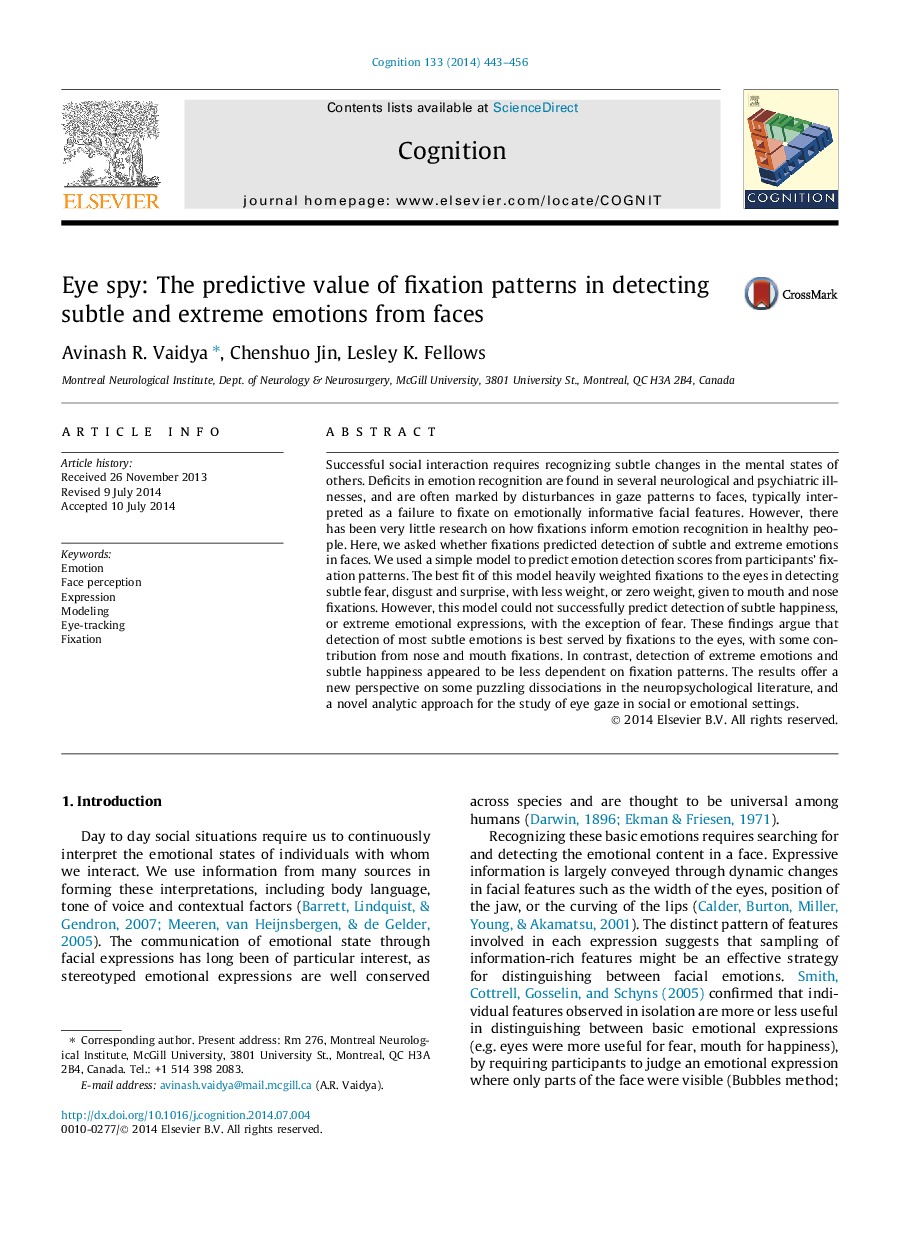| کد مقاله | کد نشریه | سال انتشار | مقاله انگلیسی | نسخه تمام متن |
|---|---|---|---|---|
| 10457511 | 921837 | 2014 | 14 صفحه PDF | دانلود رایگان |
عنوان انگلیسی مقاله ISI
Eye spy: The predictive value of fixation patterns in detecting subtle and extreme emotions from faces
ترجمه فارسی عنوان
جاسوسی چشم: ارزش پیش بینی کننده الگوهای ثابت در تشخیص احساسات ظریف و شدید از چهره
دانلود مقاله + سفارش ترجمه
دانلود مقاله ISI انگلیسی
رایگان برای ایرانیان
کلمات کلیدی
هیجانی، ادراک چهره، اصطلاح، مدل سازی، ردیابی چشم، رفع اشکال،
ترجمه چکیده
تعامل اجتماعی موفقیتآمیز نیاز به شناخت تغییرات ظریف در حالتهای ذهنی دیگران دارد. نقص در تشخیص احساسات در چند بیماری عصبی و روانپزشکی یافت می شود و اغلب با اختلالات در الگوهای دید به صورت مواجه می شوند، که معمولا به عنوان یک شکست در برطرف کردن ویژگی های احساسی اطلاعاتی صورت صورت می گیرد. با این حال، تحقیقات بسیار کمی در مورد چگونگی تشخیص احساسات در افراد سالم انجام شده است. در اینجا، ما پرسیدیم که آیا تثبیت پیش بینی تشخیص احساسات ظریف و شدید در چهره است. ما از یک مدل ساده برای پیش بینی نمرات تشخیص احساسات از الگوهای ثابت کننده شرکت استفاده کردیم. بهترین حالت این مدل فشرده سازی با شدت وزن برای چشم در تشخیص ترس ناخوش، انزجار و تعجب، با وزن کمتر یا وزن صفر به ضمیمه دهان و بینی می باشد. با این وجود، این مدل نمی تواند با موفقیت به پیش بینی تشخیص شادی ظریف و یا عبارات شدید عاطفی، به استثنای ترس. این یافته ها بیانگر آن است که تشخیص بیشتر احساسات ظریف، به بهترین شکل ممکن با فشرده سازی به چشم، با برخی از مشارکت از تنظیمات بینی و دهان است. در مقابل، تشخیص احساسات شدید و خوشبختی ظریف، کمتر وابسته به الگوهای ثابت است. نتایج به دست آمده از دیدگاه های جدید در مورد برخی از بحث های گیج کننده در ادبیات عصبی روانشناختی و یک رویکرد تحلیلی جدید برای مطالعه چشم چشم انداز در تنظیمات اجتماعی و یا عاطفی است.
موضوعات مرتبط
علوم زیستی و بیوفناوری
علم عصب شناسی
علوم اعصاب شناختی
چکیده انگلیسی
Successful social interaction requires recognizing subtle changes in the mental states of others. Deficits in emotion recognition are found in several neurological and psychiatric illnesses, and are often marked by disturbances in gaze patterns to faces, typically interpreted as a failure to fixate on emotionally informative facial features. However, there has been very little research on how fixations inform emotion recognition in healthy people. Here, we asked whether fixations predicted detection of subtle and extreme emotions in faces. We used a simple model to predict emotion detection scores from participants' fixation patterns. The best fit of this model heavily weighted fixations to the eyes in detecting subtle fear, disgust and surprise, with less weight, or zero weight, given to mouth and nose fixations. However, this model could not successfully predict detection of subtle happiness, or extreme emotional expressions, with the exception of fear. These findings argue that detection of most subtle emotions is best served by fixations to the eyes, with some contribution from nose and mouth fixations. In contrast, detection of extreme emotions and subtle happiness appeared to be less dependent on fixation patterns. The results offer a new perspective on some puzzling dissociations in the neuropsychological literature, and a novel analytic approach for the study of eye gaze in social or emotional settings.
ناشر
Database: Elsevier - ScienceDirect (ساینس دایرکت)
Journal: Cognition - Volume 133, Issue 2, November 2014, Pages 443-456
Journal: Cognition - Volume 133, Issue 2, November 2014, Pages 443-456
نویسندگان
Avinash R. Vaidya, Chenshuo Jin, Lesley K. Fellows,
